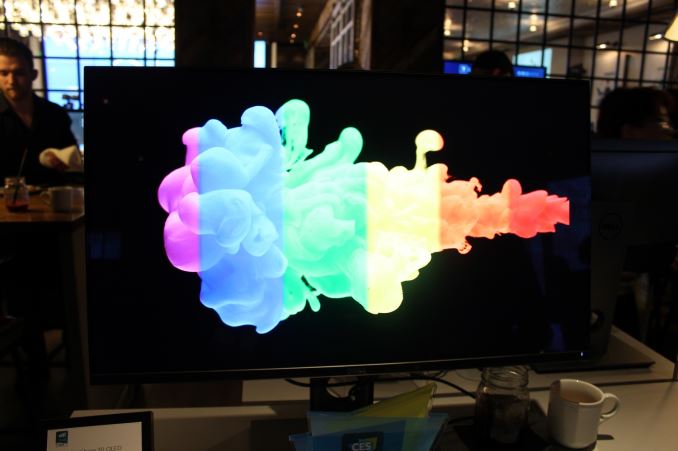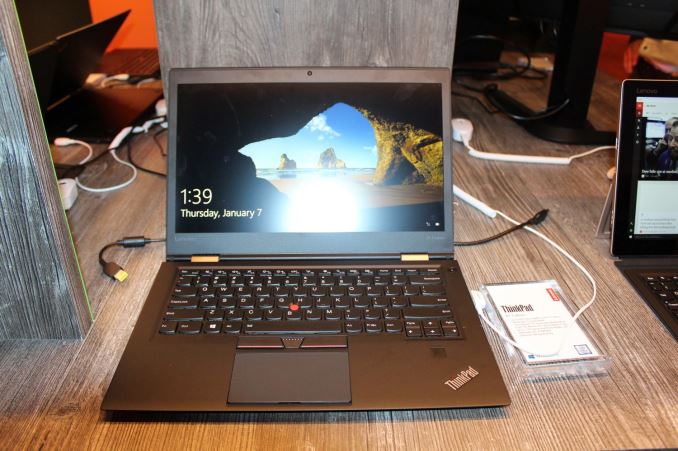CES 2016 Roundup: Total Editor Recall
by AnandTech Staff on January 26, 2016 11:00 AM EST- Posted in
- Trade Shows
- CES 2016
Senior Laptop Editor, Brett Howse
Every year we converge on Las Vegas to see all the new technology announcements from the world. The show is massive, and there is always a struggle to see as much as you can in the limited time available. This year I’ve stepped up as the senior laptop editor so there was plenty for me to cover in the couple of days I had boots on the ground, so to speak.
I think for me the most amazing announcement was the incredible number of devices that were available with OLED displays. I’ve long been a fan of the deep black levels OLED can produce and I’ve been wanting to see some on notebooks. We got that and more. There were several notebooks announced with OLED including the Lenovo ThinkPad X1 Yoga, the HP x360, and the Alienware 13, but I think the most impressive was the 30-inch Dell UltraSharp display. The price is very high but new uses of technology always start that way.
OLED is not the holy grail either. It has power draw issues on high APL workflows which is kind of the standard in the PC space. But as a first step into the PC sector, I was very impressed with the displays on all of the devices. It doesn’t even appear that the price premium is going to be that bad on the notebooks so hopefully we will see more innovation with these displays.
Another trend I’ve noticed, and this didn’t start at CES, is just how thin and light powerful notebooks have become. Everyone was keen to show off their latest notebooks based on Skylake, and it’s fairly stunning how much computer you can pack into such a small body. The LG gram is a great example of this. LG decided to use traditional Ultrabook parts in a 15-inch chassis, and when you see a 15-inch notebook under three pounds, it’s almost like it's not there. Very impressive.
Often the trade off of this is battery life though, and with the rare exception many companies have been going the smartphone route where thin and light trumps extra battery life. But even with that said, notebooks like the ThinkPad X1 Carbon got thinner and lighter this year but also increased battery capacity. High density batteries come into play here. I think it’s going to be a trend we continue to see but hopefully device efficiency makes up the difference. Everyone has different needs as far as battery life, and even the worst performers in 2016 last far longer than notebooks only a couple of years old.
The final thing I want to bring up is the decline in the PC market. Depending on what numbers you look at, the PC market dropped 6-10% in 2015 when looking at unit sales. I suppose that’s not a huge surprise considering how we interact with different devices now, and we have not seen an increase in system requirements for Windows since Vista in 2007, so old computers are still getting by. I’m as guilty of this as anyone, since I just upgraded to an i7-6700K system from an i7-860 system I believe I built in 2009. My old system was still good and rarely did I wish for more performance. Tablets have also taken some of our usage share, and with their light weight operating systems people are already finding they have a long lifespan. But despite the bad news about PC sales, it actually has been very good for consumers.
The quality of laptops released at CES were clearly a step ahead of what they have been in the past. In the past quality was secondary to quantity, but with the drop in volume, everyone has had to step up their game. Build quality, display quality, and performance have all taken a big step forward, especially for companies competing in the premium space. Users also want a nice looking laptop, and we saw the Dell XPS 13 come along last year and set the bar pretty high. Dell then took the styling and applied it to the XPS 15 to great effect, as well as their new Latitude 13. No one else is standing idle though, and there have been some excellent designs by other companies as well like the HP x360 and Lenovo 900.
So although the numbers suggest an industry in decline, I saw plenty at CES to make me hopeful for the future that at least the devices are improving for those that want them.













44 Comments
View All Comments
Ian Cutress - Tuesday, January 26, 2016 - link
We got clarification from Mushkin. Initially they will be aiming for $0.25/GB, which makes the aim south of $1000. Going down another half is a long-term goal down the line, but it won't happen overnight. I've made an addition clarifying this.hojnikb - Wednesday, January 27, 2016 - link
Its gonna take some time for nand to come down to 0.12c/GB.This probably means 3D TLC nand. I doubt 2d nand can get that cheap for ssd use.
By the time nand will be cheap enough fro 500$/4tb, im sure someone will come up with a controller capable of adressing 4TB of flash (so no need for dual controllers+ raid).
nathanddrews - Wednesday, January 27, 2016 - link
In the words of Darth Vader, "NOOOoooooOOOOooOOOOO!"It was too good to be true. :-(
Dirk_Funk - Tuesday, January 26, 2016 - link
Totally irrelevant but is that an Xbone hdmi cord coming out of the MSI tower on the first page?nathanddrews - Tuesday, January 26, 2016 - link
"This reportedly kills random access performance, but Mushkin is expecting to be able to ship the 4TB model for a mere $500, which will greatly help it find a niche."4TB of NAND for $500. Just let that sink in a bit... So basically, they're slapping two decent 2TB SSDs behind a slower controller. Here's a similar device with the same JMicron controller:
http://amzn.com/B00ITJ7WDC
What sort of random IO "killing" is happening here? To what extent? I would expect a modern SSD with low random IO to still outperform a HDD by a significant margin, but some rough numbers to put it in perspective would help. This could be awesome for a speedy micro-NAS.
Ian Cutress - Tuesday, January 26, 2016 - link
If I recall correctly, we were told '10K IOPS'. Not sure if that's read or write, or if that was the 2TB version or the 4TB version. Billy might know, he was more awake for that meeting :)Billy Tallis - Tuesday, January 26, 2016 - link
10K IOPS sounds right, but I don't have any more context for that number.Since SM2246EN drives have steady-state random write IOPS of around 5k, that metric might actually not be hurt at all by the RAID overhead. But all the other random access numbers would be.
nathanddrews - Tuesday, January 26, 2016 - link
So what you're telling me is that apart from $$/GB, one of these would make for a significant improvement in IOPS over a HDD-based file server. Say no more. ;-)jasonelmore - Tuesday, January 26, 2016 - link
I don't agree with the consensus that VIVE is better than oculus. They are different systems for different use case scenarios.The Oculus Rift is much better at long gaming sessions at your desk, like playing star citizen, euro truck, all flight sims, etc... Due to its light weight and polished design. It can still track in a small playspace, but the controllers require a additional sensor. The Oculus controllers are amazing and groundbreaking IMO. It's to bad they weren't ready to ship with the CV1.
The Vive is meant to be a system for a large play area, like the Nintendo Wii. It's much heavier, and it needs a large area to do most of interactive stuff. The controllers are not as good as oculus's (general consensus of most testers), however the lighthouse's trackers are amazing and they really do push the envelope.
Most of the demo's i've seen in larger playspaces, show the users constantly doing cable management with their feet. Your mind is thinking about the cables subconsciously thus reducing immersion.
Both have similar display specs and performance specs. (1080p @ 90FPS X 2) but Oculus seems to have more exclusives. Good guy steam will support both headsets, but Oculus will have their own exclusive titles. Maybe HTC can sign some exclusive deals, but i just don't see steam requiring you to buy their HMD to play HL3.
HTC, Steam and Oculus, need to focus on getting rid of the cables. (Maybe a Li-Fi System would have the necessary bandwidth) Wireless freedom is much more important for HTC/Steam because of the larger playspaces. I would hold off on the VIVE version 1, and see if version 2.0 is any better. Oculus will be supported by SteamVR, so Steam's involvement shouldn't make you prefer it over the Oculus.
Finally, The VIVE has not been priced yet, and HTC is not a company that can afford to subsidize the hardware. Steam maybe, but not HTC. But we shall see. I'm afraid the VIVE is gonna cost $999 and up for the HMD, 2X controllers and 2X light house sensors.
Nintendo Maniac 64 - Tuesday, January 26, 2016 - link
Is Brandon Chester not aware that LG unveiled a new OLED TV line-up for 2016 that adds support for Dolby-Vision? That by definition is an advancement.